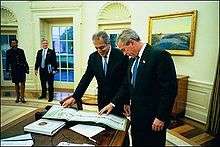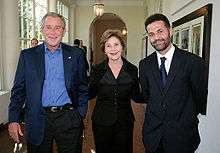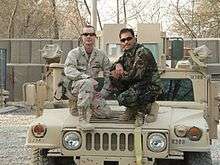Afghan Americans
| Total population | |
|---|---|
|
96,089 (2015)[1] Estimate 200,000+ (2001)[2] | |
| Regions with significant populations | |
| California, Northern Virginia, New York, Florida | |
| Languages | |
|
Majority: Pashto Minority: Dari (Afghan Persian) and other languages of Afghanistan[3] | |
| Religion | |
|
Predominantly Islam minorities of Atheism, Christianity and Judaism[4] |
Afghan Americans are Americans of Afghan descent or Americans who originated from Afghanistan. Afghan Americans may originate from any of the ethnic groups of Afghanistan.
History and population
Afghan Americans have a long history of immigrating to the United States, as they may have arrived as early as the 1860s.[5][6] A group of 200 ethnic Pashtuns were reported to be in the United States in 1920, which probably included Pashtuns from Afghanistan as well as Pashtuns from then northwestern British India (now present-day northwestern Pakistan).[6] This was around time when Afghanistan–United States relations were being established. Wallace Fard Muhammad, credited for being the founder of the Nation of Islam, may have been from Afghanistan. A World War I draft registration card for Wallie Dodd Fard from 1917 indicated he was living in Los Angeles, California, as an unmarried restaurant owner, and reported that he was born in Shinka, Afghanistan in 1893.[7] During the 1930s and 1940s, well-educated Afghans entered America.[6] Between 1953 and early 1970, at least 230 migrated into the United States.[6] Some of those who entered the US were students who won scholarships to study in American universities.
After the 1979 Soviet invasion of Afghanistan, around five million Afghan citizens were displaced, being forced to immigrate or seek refuge in other countries. These Afghan refugees mostly settled in neighboring Pakistan and Iran, and from there many made it to the European Union (EU), North America, Australia, and elsewhere in the world.
Those who were granted refugee status in the United States began to settle in the New York metropolitan area, California (mainly in the San Francisco Bay Area and the Los Angeles-Orange County area) and in the Northeastern United States, where large Muslim community centers keep them closely bonded. Fremont, California, is home to the largest population of Afghan Americans followed by Northern Virginia.[8] Smaller Afghan American communities also exist in the states of Florida, Illinois, Maryland, New Jersey, Pennsylvania, Texas, Washington and elsewhere. In the city of Chicago, the 2000 census counted 556 Afghans, approximately half of them within the city.[9]
According to the U.S. Census Bureau, there were approximately 65,972 Afghan-Americans living in the country in 2006. The American Community Survey (ACS) estimates a total of 94,726 Afghan foreign-born immigrants residing in the United States in 2016, which shows a 30% increase in the last ten years.[10] Congress passed the Afghan Allies Protection Act in 2009, which was motivated by the ongoing War on Terror. This Act stated that Afghans who agreed to work with the U.S. government as translators and interpreters in Afghanistan are eligible for special immigrant visas (SIVs) after completing one year of employment. Because these individuals put their lives at risk for the interest of U.S. intelligence, Afghans eligible for SIVs are able to use this as a pathway towards lawful permanent residence for both themselves and their immediate family members. [11]. Since 2005, tens of thousands of Afghans have been admitted to the United States under special programs such as the Special Immigrant Visa.[12] From the fiscal year of 2007 to 2015, a total of 19,916 Afghans were issued a Special Immigrant Visa. [13]
Culture
Like all other immigrants living in the United States, Afghan Americans have gradually adopted the American way of life but some still value their traditional culture. They watch Afghan television stations, listen to Afghan music, and eat traditional Afghan food at home. They also value their oral tradition of story telling. The stories they usually tell are about Nasreddin, Afghan history, myths and religion.[6]
Afghan Americans celebrate August 19 as "Afghan Day". It is a commemoration of the Afghan Independence Day, which relates to August 1919, the date when Afghanistan became globally recognized after the Anglo-Afghan Treaty of 1919 was signed. Small festivals are held in cities that have Afghan communities, usually at the parks where black, red and green colored Afghan flags are spotted around cars.[14]
Ethnicity and religion
Afghan Americans are composed of the various ethnic groups that exist in Afghanistan, which include Pashtun, Tajik, Hazara, Uzbek, and a number of others
Most Afghan Americans are Muslims, the majority of whom follow Sunni Islam, with a sizable community of Shia Muslims.
There is a community of Afghan Jews in New York City, numbering about 200 families in 2007.[4] In addition, a group of Afghan Americans in the Los Angeles area follow Christianity.[15] Hussain Andaryas is an Afghan Christian televangelist who belongs to the Hazara ethnic group.
Economic status
Afghan immigrants that arrived to the United States before 1979 were well-educated.[6] In contrast, current immigrants have fled Afghanistan after it destabilized during the 1979 Soviet occupation as this group has had trouble coping with learning a new language.[6] Those who have pursued their education in America in the middle 20th century and traveled back to Afghanistan, faced trouble attaining employment when returning to the United States since their education, often in medicine and engineering, is frequently viewed as outdated.[6] After the Soviet invasion, Afghanistan's education system worsened, causing many migrants in the late 20th century to place less emphasis on educational attainment.[6]
Some of the latest Afghan immigrants can be found as vendors in Manhattan where they have replaced Greek Americans in the field.[16]
Smaller number of Afghans have entered the professions of medicine, law and engineering.
Notable people
| Lists of Americans |
|---|
| By U.S. state |
| By ethnicity or nationality |
|



Politics, academia and literature
- Ali Ahmad Jalali – Distinguished Professor at the National Defense University in Washington, D.C.
- Said Tayeb Jawad – Ambassador of Afghanistan to the United States from 2003 to 2010
- Zalmay Khalilzad – United States Ambassador to the United Nations from 2007 to 2009. He previously served as United States Ambassador to Afghanistan and United States Ambassador to Iraq
- Mohammad Qayoumi – Former President of San Jose State University
- Nazif Shahrani – Professor of anthropology at Indiana University
- Joseph Barjis – Professor of Information Technology at San Jose State University
- Ishaq Shahryar – Afghan Ambassador to the United States from 2002 to 2003
- Wali Karzai – Professor of Bio-Chemistry at Stony Brook University
- M. Ishaq Nadiri – Professor of economics at NYU[17] and signatory at 2001 Afghanistan Bonn conference
- Isaac Barjis – Professor of Biology at CUNY[18]
- Nake M. Kamrany – Professor of economics at University of Southern California [19][20]
- Haris Tarin – Director of Muslim Public Affairs Council ( MPAC)[21]
- Tamim Ansary – Author of West of Kabul, East of New York, a book published in 2001, shortly after the "9-11" attacks.
- Khaled Hosseini – Best-selling author whose work includes The Kite Runner and A Thousand Splendid Suns
- Fariba Nawa – Author of Opium Nation and journalist
- Qais Akbar Omar – Author of A Fort of Nine Towers and co-author of Shakespeare in Kabul
- Jeffery Atik – Professor of Law at Loyola Law School, Los Angeles [22]
- Hamid Naweed, author and art historian
- Zalmai Azmi – Former Chief Information Officer of the FBI
- Ali Latifi – Journalist based in Afghanistan
Business and finance
- Mahmoud Karzai – Brother of former Afghan President Hamid Karzai and owner of Afghan cuisine restaurant
- Qayum Karzai – Brother of former Afghan President Hamid Karzai and owner of Afghan cuisine restaurants in the Southern California and Baltimore–Washington Metropolitan Area
- Ehsan Bayat – Business entrepreneur who founded Afghan Wireless
- Abdul W. Haqiqi – Economist and co-author of a number of published and cited works concerning Islamic banking accounting standards
Sports
- Adam Najem – plays for the Afghanistan national football team and Philadelphia Union in Major league soccer
- David Najem – plays for the Afghanistan national football team and Tampa Bay Rowdies in the United soccer league
- Alex Hinshaw – Former baseball pitcher[23]
- Jeff Bronkey – Former baseball player[23]
- Ahmad Hatifi – Plays for Afghan national football team[24]
Media and art

- Azita Ghanizada – Actress and TV host, she appeared in a number of films and TV shows
- Sonia Nassery Cole – Actress and director
- Anwar Hajher – Filmmaker and professor, 16 Days in Afghanistan
- Youssof Kohzad – Artist, Poet, Painter and Actor
- Zakia Kohzad – Former Afghan actress and news anchor
- Mithaq Kazimi – Filmmaker, producer of 16 Days in Afghanistan
- Nabil Miskinyar – Television anchor
- Jawed Wassel – Writer/Director of first Afghan Oscar contender Feature Film called FireDancer.
- Josh Gad – Actor appearing in Frozen and Jobs. Afghan-Jewish father.
- Leena Alam – Actress from Kabuli Kid, Loori, Soil and Coral, and The Unknown
- Fahim Fazli – Actor who appears in various films, such as Iron Man[25]
- Robert Joffrey – born Abdullah Jaffa Bey Khan is known for co-founder of the Joffrey Ballet
- Aman Mojadidi – Artist whose art focuses on Afghan politics and cross-cultural identity[26]
- Noor Wodjouatt, founder of Zarin TV and performer at Kennedy Center
- Sedika Mojadidi – Documentary filmmaker and producer, Facing the Dragon
Afghan music singers
- Farhad Darya – Singer of Afghan music
- Jawad Ghaziyar – Singer of Afghan music
- Rahim Jahani – Singer of Afghan music
- Naim Popal – Singer of Afghan music
- Mariam Wafa – Singer of Afghan music
- Ahmad Wali – Singer of Afghan music
- Omar Akram – Afghan American Pianist who won a Grammy award for best new age album [27][28]
- Aziz Herawi- Famous Afghan Classical musician
Beauty pageant contestants
Afghan royalty
- Ahmad Shah Khan – Former Crown Prince of Afghanistan and current pretender to the throne
Other
- Alexander Benard – lawyer and businessman who is the son of Zalmay Khalilzad
- Hevad Khan – professional Poker player[29]
- Ahmad Khan Rahami – suspect in the 2016 New York and New Jersey bombings
- Omar Mateen – perpetrator of the 2016 Orlando nightclub shooting
- Stephen J. Townsend, U.S. Army officer, former Commander of Combined Joint Task Force – Operation Inherent Resolve (Afghan father)
- Rishad Zahir – son of Afghan singer Ahmad Zahir
- Zahira Zahir – sister of Afghan singer Ahmad Zahir
- Najibullah Zazi – pleaded guilty to being part of the 2009 U.S. Al Qaeda group that planned suicide bombings on the New York City Subway system
America's longest war

After the September 11 attacks in 2001, a mosque run by Afghan-Americans in New York City donated blood, held a vigil for those who died inside the World Trade Center (WTC) and funded a memorial for NYC fire fighters.[30] Since late 2001, after the start of America's longest war, many Afghan-Americans have worked alongside the United States Armed Forces as interpreters, contractors and journalists. A number of them were wounded or killed while on duty inside Afghanistan.
See also
References
- ↑ "2015 American Community Survey 1-Year Estimates: Afghan". United States Census Bureau. Retrieved December 30, 2016.
- ↑ Ritter, John (September 19, 2001). "'Little Kabul' immigrants apprehensive". USA Today. Retrieved December 30, 2016.
- ↑ Jonathan H. X. Lee; Kathleen M. Nadeau (2011). Encyclopedia of Asian American Folklore and Folklife. 1. ABC-CLIO. pp. 105–123. ISBN 978-0-313-35066-5. Retrieved January 22, 2016.
- 1 2 "U.S.: Afghan Jews Keep Traditions Alive Far From Home". Nikola Krastev. Radio Free Europe/Radio Liberty (RFE/RL). June 19, 2007. Retrieved September 7, 2013.
- ↑ "Private Mohammed Kahn: Civil War Soldier". catalog.archives.gov. June 23, 2017. Retrieved July 7, 2017.
- 1 2 3 4 5 6 7 8 9 Tim Eigo (2006). "Afghan Americans". everyculture.com. Retrieved January 22, 2016.
- ↑ Ancestry.com database, Registration Location: Los Angeles County, California; Roll: 1530899; Draft Board: 17
- ↑ Matthew B. Stannard (August 21, 2009). "Fremont's Little Kabul eyes election with hope". San Francisco Chronicle. Retrieved January 22, 2016.
- ↑ Daniel Greene (2004). "Afghans". Encyclopedia.chicagohistory.org. Retrieved January 21, 2016.
- ↑ "2016 American Community Survey 1-Year Estimates: Afghan". United States Census Bureau. Retrieved February 9, 2018.
- ↑ https://www.humanrightsfirst.org/sites/default/files/Afghan-SIV-Fact-Sheet-Dec-2016.pdf
- ↑ https://travel.state.gov/content/dam/visas/SIVs/Afghan%20SIV%20public%20report_Jan%202016.pdf
- ↑ http://trac.syr.edu/immigration/library/P8979.pdf
- ↑ "Embassy Celebrates Independence Day". Afghan Embassy news letter. August 2006. Archived from the original on June 17, 2010.
- ↑ "Afghan Christian Fellowship, Los Angeles". afghanchurch.net. Retrieved March 17, 2015.
- ↑ Mirta Ojito (September 18, 1997). "The Face Behind the Bagel - Afghan Newcomers Use Coffee Carts to Succeed As Vendors of New York's Rush-Hour Breakfast". New York Times. Retrieved January 21, 2016.
- ↑ "M. Ishaq Nadiri, Faculty of Department of Economics – NYU". Retrieved 17 March 2015.
- ↑ "Faculty Profile: Isaac Barjis". New York City College of Technology.
- ↑ "Nake M. Kamrany". Retrieved 17 March 2015.
- ↑ "Nake M. Kamrany, Ph.D., J.D." Retrieved 17 March 2015.
- ↑ "Rising Muslim American leader in D.C. speaks for his generation". Washington Post. November 11, 2012. Retrieved 17 March 2015.
- ↑ http://www.lls.edu/faculty/facultylista-b/atikjeffery/
- 1 2 "Blue Jays: Pitcher Hinshaw comes from exotic background: DiManno". thestar.com. February 21, 2013. Retrieved 17 March 2015.
- ↑ "Ahmad Hatifie Bio – UC Davis Official Athletic Site". ucdavisaggies.com. Retrieved March 17, 2015.
- ↑ "Authors". Fahim speaks. Retrieved March 17, 2015.
- ↑ Aman Mojadidi, Special to CNN (January 27, 2013). "An 'Afghan redneck' creates art in a war zone". CNN. Retrieved March 17, 2015.
- ↑ "Omar Akram". Last.fm. Retrieved March 17, 2015.
- ↑ "Omar Akram". The GRAMMYs. Retrieved March 17, 2015.
- ↑ Nicole Gordon. "The PokerNews Profile: Hevad Khan". pokernews.com. Retrieved March 17, 2015.
- ↑ "BBC News - AMERICAS - Troubling times for Afghan-Americans". BBC.uk. Retrieved March 17, 2015.
External links
| Wikimedia Commons has media related to Americans of Afghan descent. |
